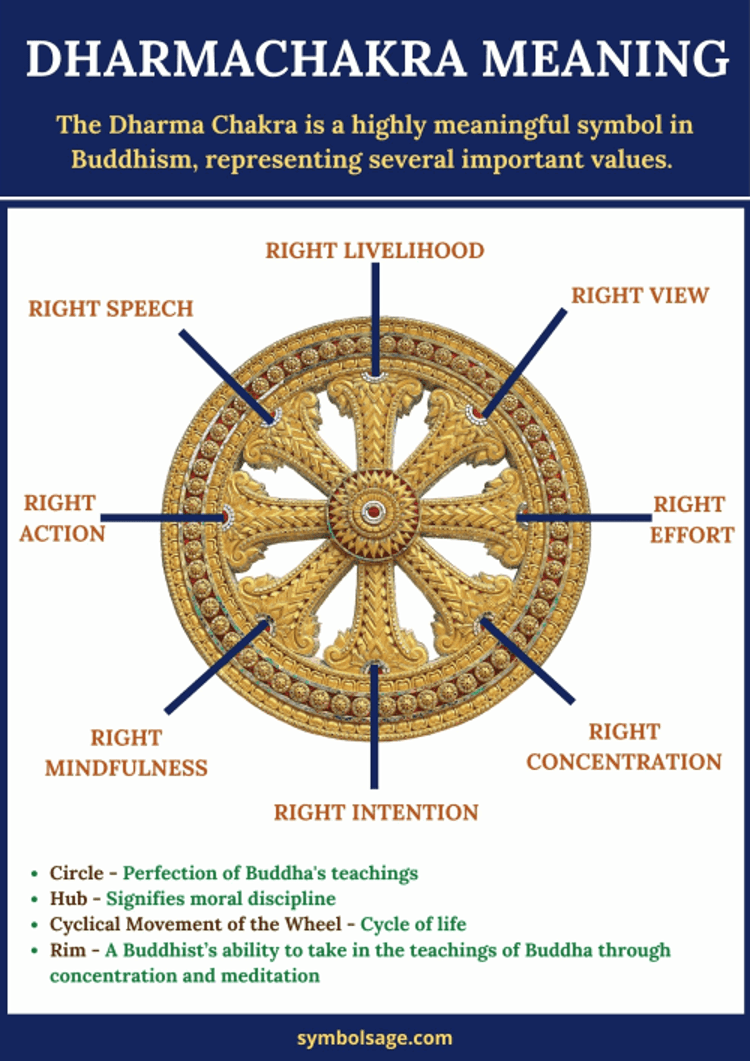
Achieving freedom from the eternal cycle of suffering has been the goal of Buddhism since the religion’s very inception and it’s something most people struggle with to this day. Has Buddhism found an answer in avoiding samsara, the cycle of suffering? According to Buddhism, that’s what the Noble Eightfold Path is.
In essence, the Noble Eightfold Path is an early and succinct summary of the eight Buddhist practices believed to help lead people to liberation from the torturous cycle of life, suffering, death, and rebirth. In other words, the Noble Eightfold Path is the path to Nirvana.
What Are the Key Principles of The Noble Eightfold Path?
The Eight Noble Paths of Buddhism are quite intuitive and follow one another in a logical pattern. They are usually represented with the Dharma wheel symbol and they read like this:

- Right view or understanding (Samma ditthi)
- Right resolve, intention, or thought (Samma sankappa)
- Right speech (Samma vaca)
- Right action or conduct (Samma kammanta)
- Right livelihood (Samma ajiva)
- Right effort (Samma vayama)
- Right mindfulness (Samma sati)
- Right concentration (Samma samadhi)
The word “Right” is repeated every time because, in Buddhism, people are viewed as inherently faulty or “broken”. This refers specifically to the connection between the body and the mind. It’s that disconnect between the two that keeps people away from achieving Enlightenment and from there – Nirvana, the state of complete non-suffering in Buddhism.
To get to that point, the Buddhist must first right the wrongs in its being, hence why each of the eight steps above needs to be done “right”.
So, one needs to first achieve the right understanding through learning, then start forming the right thoughts, learn the right speech, start acting in the right way, then achieve the right livelihood, put in the right effort, get into the right mindfulness, and lastly start practicing the right concentration (or meditation) to truly realign the body with the soul.
The Threefold Division of the Eightfold Path

Most schools of Buddhism tend to group the eight principles into three broader categories to make them easier to understand and teach. This Threefold Division goes like this:
- Moral or Ethical Virtue, including the right speech, the right conduct/action, and the right livelihood.
- Mental Discipline or Meditation, including the right effort, the right mindfulness, and the right concentration.
- Wisdom or Insight, including the right view/understanding and the right resolve/thought.
The Threefold Division rearranges the eight principles of the Noble Eightfold Path but only does so to help us understand their meaning.
Ethical Virtue
The Threefold Division starts with the three ethical virtues even though they are points #3, #4, and #5 on the Dharma wheel/list. It does so because they are the ones easier to understand and practice.
How to speak, how to act, and what type of livelihood to achieve or strive for – these are things people can do even at the very beginning of their journey into Buddhism. Furthermore, they can also make the next steps easier.
Mental Discipline
The second group of principles includes the ones that come last – 6th, 7th, and 8th – on the Dharma wheel. Those are the principles one starts trying to master when they truly and fully commit to the ways of Buddhism. Putting in the effort to live a righteous life within as well as without, focusing on your mindfulness, and trying to master your meditation are all key to reaching Enlightenment.
Additionally, like the three Ethical principles, these three are ones that take practice too. This means that all Buddhists can and should start practicing Mental Discipline early in their path to Enlightenment even as they still work to acquire the right understanding and resolve.
Wisdom
The third group of the Threefold Divide involves the first two principles of the Noble Eightfold Path – the right understanding and the right thought or resolve. While they are technically the first on the Dharma wheel as they are meant to precede speech and action, they are often the last to start focusing on as they are the hardest to understand.
That’s why the Threefold Divide first focuses on the actions one must take – both externally through Ethical Virtues and internally through Mental Discipline – as that helps us acquire more Wisdom. That, in turn, helps our Ethical Virtues and Mental Discipline, and so the Dharma wheel turns faster and smoother until we manage to achieve Enlightenment and Nirvana.
The Noble Tenfold Path

Some Buddhists believe that there are two additional principles that belong on the Dharma wheel, making it a Noble Tenfold Path rather than Eightfold.
The Mahācattārīsaka Sutta, for example, which can be found in both Chinese and Pali Buddhism canons, also talks about the Right Knowledge or Insight (sammā-ñāṇa) and the Right Release or Liberation (sammā-vimutti).
Both of those belong in the Wisdom category of the Threefold Divide as they are also meant to lead to the Right Speech and Right Action on the Dharma wheel.
In Brief
The Noble Eightfold Path has been the cornerstone of most main schools of Buddhism for as long as this ancient eastern religion has existed. It outlines the eight basic principles and acts everyone must follow if they are to free themselves of samsara and achieve Nirvana.
Understanding, thought, speech, action, livelihood, effort, mindfulness, and concentration (or meditation), all done in the right way, according to Buddhists, are guaranteed to eventually elevate one’s mind and soul above the hardships of the death/rebirth cycle and into Enlightenment.








